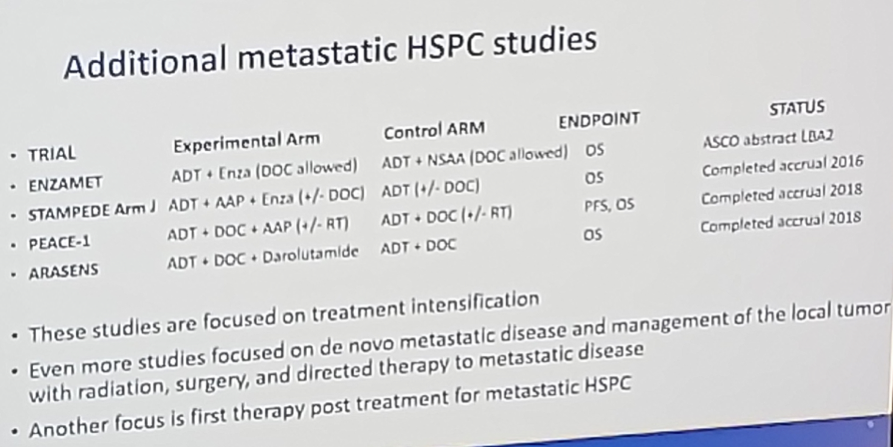Dr. Carducci highlights that there are three main points that we have learned from these abstracts:
- ADT and apalutamide for mCSPC improves survival and thus reinforces the recent standard of ADT plus single-agent docetaxel, abiraterone, enzalutamide, or apalutamide
- Bisphosphonates (zoledronic acid) and RANK ligand inhibitors (denosumab) dramatically reduce fractures in patients on enzalutamide or the combination of radium-223/enzalutamide
- The combination of enzalutamide/abiraterone did not prolong survival over enzalutamide alone in men receiving first-line therapy for men with mCRPC
So, where are we? mHSPC is broadly heterogeneous state and treatment benefit is not consistent in all clinical subsets based on the current classification. He thinks that new methodology based on specific molecular taxonomy, in addition to conventional clinical/pathological factors may provide better risk classification and predict response to treatment – ie. PTEN loss, p53 loss, RB1 loss, DNA repair mutation, etc. Practically speaking Dr. Carducci notes that combination ADT and chemo or androgen targeted agents is the standard of care for mHSPC, and apalutamide clearly fits in this space. However, there are various scenarios that one must consider when assessing how patients arrived at mHSPC:
- The patient with BCR seeking to defer the negative aspects of ADT who subsequently develops a new metastatic lesion
- Oligometastatic disease – the “low low” volume or the not high-volume patient
- The elderly patient concerned about feeling old and frail
- The underinsured patient struggling with cost of medications/duration of therapy

Men on ADT have a greater risk of fracture and yet most have not been clinically significant according to Dr. Carducci, noting that this plays to the timing of ADT use in clinical practice. Bone-targeted agents like zoledronic acid and denosumab decrease skeletal-related events and reduce fractures. Yet, skeletal-related events still occur. Dr. Carducci thinks that bone-targeted agents are confusing based on risks, dose, schedule, duration, and what disease state to give them in. Furthermore, he notes that these agents increase the cost and frequency of visits and monitoring. However, he clarifies that he was delighted that bone-targeted agents decreased the fracture rate in the EORTC 1333/PEACE III trial.
The results of ERA 2231 and EORTC 1333/PEACE III show that we need to pay attention to fracture risk/incidence. However, in Dr. Carducci’s opinion, it is not completely comprehensible that two active agents that improve the clinical outcome of skeletal-related events had more fractures and higher-risk of death. He notes that this may be secondary to men with metastatic disease living longer: (i) men with mHSPC receive additional lines of therapy, and (ii) men with non-metastatic CRPC have longer MFS with drug exposure. Certainly, there appears to be an interaction with radium-223 and potent androgen targeted agents and perhaps an interaction of prednisone with radium-223 and androgen targeted agents. Practice changes according to Dr. Carducci are that bone-targeted agents should be standard of care when using radium-223, and that a skeletal-related event should prompt use of a bone-targeted agent. However, he notes that more research is needed with bone-targeted agents to satisfy the skeptical clinician and patient cautious of side effects and additional visits/monitoring.
Dr. Carducci states that Alliance 031201 was an important study with a timely and significant question for clinical practice. The rationale was adequate and the trialist chose the right endpoint (overall survival). This is important considering that for two agents that extend rPFS, we are hard-pressed to determine clinically meaningful rPFS extension when side effects and costs are likely to be greater with the combination therapy. This was a negative study, thus single agent abiraterone or enzalutamide in the first or second line mCRPC remains the standard of care.
For androgen targeted therapy, is more better?
- Alliance 031201 suggests that more is not better in the first line mCRPC setting
- Yet, we have an ever-changing landscape and desire to intensify given the availability of potent androgen targeted therapy advances in mHSPC and nmCRPC
- The risk of progress and death is still crude and with a range of outcomes/variability not yet fully understood
- The clinic still has a lot to teach us – for those with fast-paced disease, we do need to think quicker, develop new drugs based on the targets and molecular features of these tumors, yet be mindful that their time may be short and more intense therapies, unless beneficial, can make that time miserable
- There are many men that grow old with us as we manipulate the drug options we have and try not to change therapies too fast and being mindful that these therapies may extend their survival with prostate cancer, but with a toll on their quality of life and added cost/risks
Written by: Zachary Klaassen, MD, MSc – Assistant Professor of Urology, Georgia Cancer Center, Augusta University/Medical College of Georgia, @zklaassen_md at the 2019 ASCO Annual Meeting #ASCO19, May 31-June 4, 2019, Chicago, IL USA
Reference:
- Smith M, Parker C, Saad F, et al. Addition of radium-223 to abiraterone acetate and prednisone or prednisolone in patients with castration-resistant prostate cancer and bone metastases (ERA 223): A randomized, double-blind, placebo-controlled, phase 3 trial. Lancet Oncol 2019 Mar;20(3):408-419.


